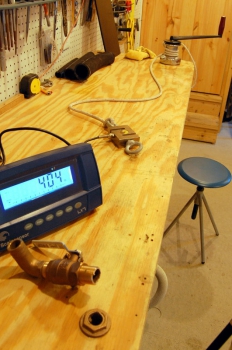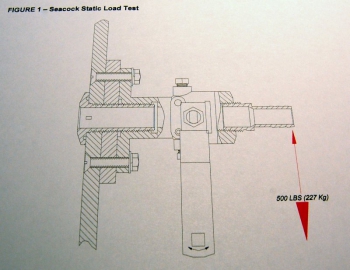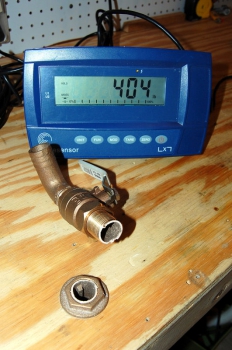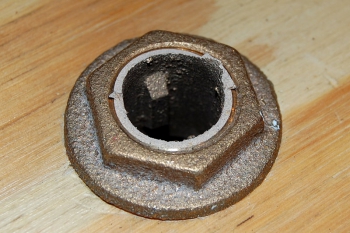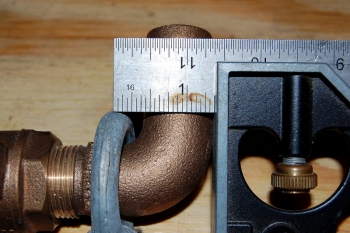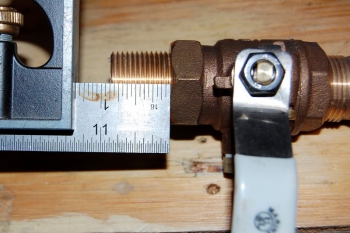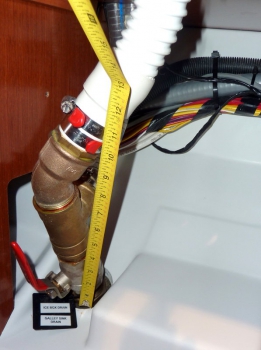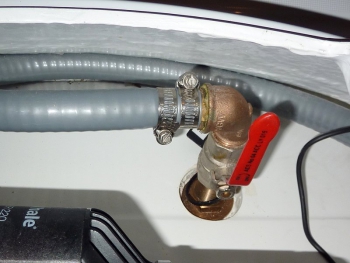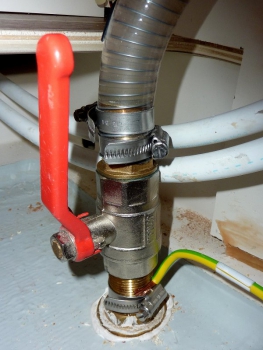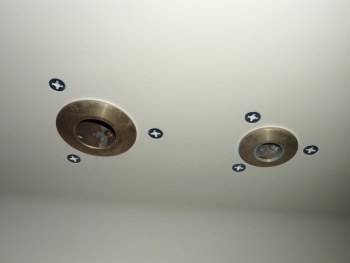The Test Bench
I had been meaning to test the strength of a ball valve threaded directly onto a thru-hull, as many production builders do for seacock installations, but never actually got around to completing that task until now.
Many of the builders, who install seacocks in this manner, very often display the ABYC logo quite proudly suggesting their vessels are actually built to meet the minimum safety standards. In all fairness to the builders I suspect they actually believe these installations do or would meet the minimum safety standards but as I found out they certainly may not.
We can’t really blame the builders for installing UL Marine parts and then not having them meet the minimum standards, or can we? While a boat owner may assume the manufacturers would have tested these fittings for the application into which they are sold, they clearly have not.
As conducted the testing, to ABYC standards, it became apparent that a 3/4″ Marine UL bronze valve threaded to a 3/4″ Marine UL rated thru-hull fitting, does not meet ABYC H-27 Standards.
FAILURE = 404 Pounds
REQUIREMENT = 500 Pounds for 30 Seconds
This set up failed at just 404 pounds and I was an 1 3/8″ below the inboard end of the assembly so I had slightly less leverage than I would have had I been able to apply the load at the absolute inboard end of the assembly. The assembly includes all the hard piping usually ending with a male hose adapter or other bronze or Marelon fitting.
The bare minimum strength requirement, for installed seacocks under ABYC H-27, is to support a 500 pound static load for 30 seconds at the inboard end of the installed assembly.
Does this test mean a seacock like this will fail in normal use? Probably not but there is a higher probability than a seacock assembly that actually meets the ABYC standard. We had one fail on us when a spare alternator slid across a shelf and hit the in-board end of a seacock assembly, so it can/could potentially happen and has happened.. That event scared the living crap out of me and made me a firm believer in proper flanged seacocks.
When buying a boat with this type of installation please be aware of and know that it is, and can be, a potential week point that may not meet the minimum ABYC safety standards for seacocks and thru-hull fittings, at least in the 3/4″ size range.
EDIT: I later tested a 1″ thru-hull & ball valve combo and had it fail at below 500 pounds as well. It failed at 458 pounds.
The Safety Standards
ABYC H-27 Definitions:
27.4.4 Seacock – A type of valve used to control intake or discharge of water through the hull. It is operated by a lever type handle usually operating through a 90° arc, giving a clear indication of whether it is open or shut, and is typically of the two following types:
27.4.4.1 Flanged Sea Valve – A Seacock with an integral flange used to individually and securely mount the device directly to the boat hull structure.
27.4.4.2 In Line Ball Valve – A Seacock designed to be supported entirely by the through-hull fitting.
ABYC H-27 Key Points:
27.5.1 All piping, tubing, or hose lines penetrating the hull below the maximum heeled waterline, shall be equipped with a seacock to stop the admission of water in the event of failure of pipes, tubing, or hose.
27.5.4 Seacocks shall be designed and constructed to meet ANSI/UL 1121, Marine Through-Hull Fittings and Sea-Valves.
27.5.5 Thru-hull fittings shall be designed and constructed to meet ANSI/UL 1121, Marine Through-Hull Fittings and Sea-Valves.
27.6.1 A seacock shall be securely mounted so that the assembly will withstand a 500 pound (227 Kg) static force applied for 30 seconds to the inboard end of the assembly, without the assembly failing to stop the ingress of water.
27.6.1.1 The installation shall prevent any movement of the assembly.
27.6.1.3 Threads used in seacock installations shall be compatible (eg. NPT to NPT, NPS to NPS).
The Testing
The Test
The tests were performed in my shop using the work bench as the test jig. I was planning to rig up some 5/8″ thick fiberglass and bolting it to the bench using some big backing plates but after running some numbers it appeared the 3/4″ plywood should handle the loads, and it did.
To measure the load on the seacock I used a calibrated digital load cell and applied the load gradually to the seacock per ABYC/UL testing procedures. The load was measured in pounds and set to capture the moment of failure or “peak hold”. To apply the load gradually and steadily I used an old Lewmar self tailing winch attached to the end of the work bench.
The thru-hull was fitted to my bench and tightened down well using a spud wrench. The valve was then threaded onto it and the elbow threaded into the valve. I was able to get 4 full turns on the valve to thru-hull.
The ball valve to thru-hull is a known thread mismatch, NPS to NPT, but this is what is very often done by builders, boat yards and DIY’s. I wanted to mimic a “real world” type installation and most, at least in bronze, are of mixed parts, not just one brand. It was not the thread mismatch that failed.
This image shows a close up of the failure. It’s not a surprise that it failed where it did.
Materials
The materials for this test were all off the shelf UL Mairne products. I purchased everything from Hamilton Marine in Portland, ME.
To mimic what a boat owner, or boat yard may install, the components were a mix of what was on hand at the chandlery. The bronze UL Marine thru-hull fitting was made by Apollo/Conbraco, the UL Marine valve by Groco and the bronze elbow was also manufactured by Groco.
Where The Load Was Applied
If you look at the video you’ll see where the “load” was applied to the elbow which is a full 1 3/8″ inward of where the ABYC load is to be applied at the inboard end of the assembly. Here I’m measuring the load contact point from the inboard end of the assembly.
I just did not have a good way to apply the load to the actual inboard end of the assembly of this particular 90 degree hose adapter. In the process I gave up 1 3/8″ of lever. Moving down 1 3/8″ on the assembly actually favors the seacock when testing to ABYC H-27 standards. Despite this 1 3/8″ of favorable advantage, for the seacock assembly, the thru-hull still failed at 404 pounds and never got close to 500 pounds for 30 seconds.
The Inboard End
On the inboard end there was just 7/8″ of exposed thru-hull which, as I previously mentioned, mimics the installations I see on a daily basis. When I see a valve on a thru-hull I rarely if ever see them cut shorter. It would certainly help to make the assembly shorter but I just don’t see this done very often.
Even if I managed to get the valve within 1/8″ of the thru-hull nut, and then moved the load to the proper positioning for ABYC H-27, the thru-hull would have still failed at well below the standard of 500 pounds at the inboard end of the assembly for 30 seconds.
This Was a 2011 Production Sailboat
Keeping the assembly shorter and closer to the hull would definitely help and limit the lever-arm that could be applied to the thru-hull but in this case they actually added to the height. Ouch!! A flanged seacock would be significantly stronger in this application and should meet the 500 pound standard even using this myriad of hard piping.
How about this builder….. Someone paid over $200k for this boat! Is this type of installation worthy of $200,000.00 ? I’ll let you be the judge.
In an installation like this the seacock assembly should end at the male hose adapter, then have soft hose, then any additional piping. Instead this builder decided to make the inboard end of the assembly nearly 1 foot tall… What is it Forest Gump used to say…?
Cut It Shorter?
As I mentioned builders rarely, if ever, cut the thru-hulls shorter for better strength characteristics. Cutting them shorter would reduce the lever-arm but negate any thread match if a combination threaded thru-hull was used. A real Catch 22 for a builder who likes to pinch pennies….
Please click on this photo and ask yourself how one might actually get to the thru-hull nut if you needed to? Is this level of build acceptable on a $329,000.000 vessel?
The Only Reason…
The builders get away with installations like this, because we the buyers allow it.
If you want better construction techniques keeping your family afloat, it needs to start with us, the consumer. This was another 2011 brand spanking new six figure vessel.
Have Faith….
Some builders do spend the time to make their vessels safe & robust. This was also a 2011 production sailboat. She had been fitted with bronze flanged seacocks, utilized solid fiberglass backing plates and the flanges were through bolted to the solid fiberglass hull. While some builders are off pinching pennies other builders actual do care about below waterline integrity.
If I was paying six figures for a vessel, & I did in 2005, I would expect well fitted, robust below water seacocks in either Marelon or bronze. As a buyer you should demand more than the crap some of these builders are stuffing you with…
A Proper Installation in Bronze
Your below waterline seacocks are not a joke, not optional and are not a place to cut corners. Consider what is between you and the open ocean before plunking down 150K- 400K on a penny pinched vessel. Before taking deliver of a vessel, with a piss-poor seacock installation, do your best to negotiate proper seacocks into the deal. I would suggest refusing to take delivery until proper flanged bronze or Marelon OEM / 93 Series seacocks have been installed.

